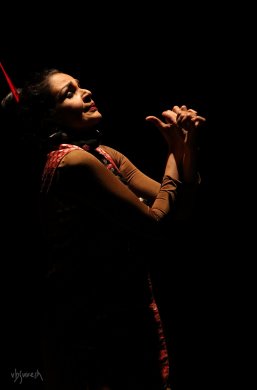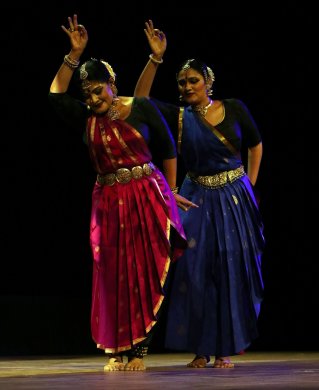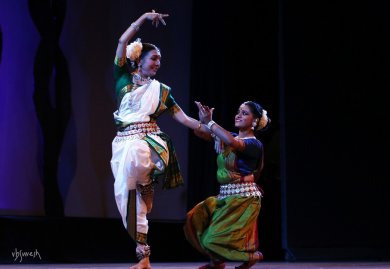
|   |

|   |
 e-mail: sunilkothari1933@gmail.com Sanjali's Pravah Dance Festival in memory of Guru Kelucharan Mohapatra Photos: VB Suresh May 24, 2019 Anita Ratnam's Ma3ka Opening the Pravaha Dance Festival organized by Sanjali Dance Company of Odissi dancer Sharmila Mukerjee at Chowdaiah Hall, Bangalore on 13th April, Anita Ratnam presented in her Neo Bharatam style, her work 'Ma3ka' that she had conceived and choreographed in 2009. In her choreographer's note, Anita mentions: 'Every ten years I revisit a work of mine because I want to see if what I created continues to be relevant. Today the audience demographic is almost new, their attention span is much shorter, and also to reach out to the new audience it is important to retrace past works. I was inspired reading Shri Aurobindo's book The Mother...in Ma3ka, I explore the three facets of Aurobindo's the divine feminine - Saraswati, Lakshmi and Meenakshi.'  I had first seen it at Krishna Gana Sabha ten years ago. Elegant, tall and dressed in a white costume on which were woven three A, representing her grandmother, herself and her daughter, Anita stood next to a sari hung from the ceiling; as it were, it was down memory lane. Anita speaks of her grandmother contextualizing with what was her grandmother's life. Her paatti ma named Saraswati, who was denied education, studied English herself at age of 8, was married at 14, grew up looking after the family, was widowed at 40 but was a courageous woman. Anita has also qualified her work as personal diaries. 'My daughter, first born, stubborn but sensitive, loves words and is a writer, Arya Saraswati. She is also a fashionista, and a strong woman.' Anita has used a kavutvam reinforcing faith in the Goddess of Learning. She uses simple Bharatanatyam movements to the simple mnemonics. Then in her interpretation of Lakshmi, the Goddess of Wealth, Anita comes close to a stand on which are draped various clothes. She changes in full view of the audience and turns into a glamourous woman, and to the background of the singing of Bhagyada Lakshmi, she announces: 'Welcome a lady of Lotus. She has deep secrets and beauty.' She takes off asking questions: 'What have we made of Lakshmi today? She has turned into luxury brands, phones.' Anita comes into her own, with goggles, lipstick, walking like a fashion model on a ramp, a classical dancer, a film star, to the music of Aretha Franklin, P. Susheela, and audience at once knows what Anita offers as critique of Lakshmi. The recitation of 'Shuddha Lakshmi, Mahalakshmi, namostute' throwing coins on the floor, removing her ankle bells, and also a long plait, putting it on the floor. The entire presentation borders on dance-theatre. But it is in the third segment as Meenakshi, changing into striking costumes with green colour on forehead, she turns into warrior Meenakshi, with three breasts. Daughter of Pandya Raja, Pandya Bhupala Putri, Meenakshi Madurai, she arrives with the sound of the conch. She wields a bow and arrow, aiming at Lord Shiva, who is now Sundareshwara, dressed not in a tiger skin, not besmeared with ash, but dressed in golden cloth, literally Sundar - handsome. She invites him to be one with her. 'I with my three breasts, you with your three eyes, we are a perfect match. I ardha-nara, half-male, you ardha-nari, half-female,' referring to Lord Shiva as Ardhanarishwara. It is striking, the shadows larger than life fall on stage, and Anita's stance of a warrior coalesces dramatically. She conveys that a woman today needs the strength of third breast or the masculine energy. She wants to call her work 'not one of an activist, but it is the celebration of the female.' A word about the costumes. Originally they were designed for Saraswati and Lakshmi by Rex and also the props. Meenakshi costume is designed by Sandhya Raman. Music was arranged by Vedant Bhardwaj. Female vocalist was Subhiksha Rangarajan. Choreography and direction was by Hari Krishnan, script by Anita Ratnam, inspired by Shri Aurobindo's monogram The Mother. Bharatanatyam by Geeta Chandran and Sharanya Chandran  Geeta Chandran and her daughter Sharanya Chandran presented Bharatanatyam, solo and duet. Geeta is a seasoned dancer, with lot of experience performing as a solo dancer and also as a choreographer. Under the aegis of her institution Natya Vriksha, she and her husband Rajiv Chandran organize for past 15 years, a two day World Dance Day festival, curating it with thematic talk. Sharanya presented tillana in Yaman Kalyani raga with flair. She has a tall and graceful frame. Trained thoroughly under her mother and participating in her choreographic works, Sharanya has commendable grasp of the Bharatanatym idiom, with sparkling nritta and pleasant abhinaya. In tillana, she executed the movements with exacting teermanams, moving long arms in geometrical proportion, highlighting the structure of Bharatanatyam. The interpretative shloka in the end impersonating Krishna playing flute and gopis mesmerized by listening and watching him dance was danced in an effortless manner. A word about the costume. The frills surrounding her waist did not add anything to the movement. Mere attempt at novelty does not add to the beauty of Bharatanatyam.The costume has to be comfortable for executing movements. This particular costume did not enhance the beauty of the dance form. Geeta took up Nagendra Haraya shloka in praise of Lord Shiva. She displayed the various sthanas of the body for panchakshara mantra Om Namah Shivaya. Then she dealt with complete involvement in describing Lord Shiva's adornments. The fire in one hand looked fiery, damaru reverberated with sound, mandarmala was made of flowers collected and woven well, the third eye opened and turned Kamadeva into ashes, the serpents entwined round neck and as ornaments near wrist; the tandava dance pose saw Geeta in a rock steady posture and ending the performance, she suggested how kundalini shakti was aroused reaching the top of the head. These suggestive gestures give her dance strong communicative power. Mother and daughter performed Varsha, based upon Kalidasa's Ritusamhara. It is the end of Grishma, with its scorching heat, people wanting to quench the thirst, and suddenly the sky is overcast with the thundering of clouds. Kalidasa describes it as the sound of elephants marching for a royal wedding. The English translation was spoken with enough drama by Rajiv, but the Sanskrit rendering elevated the abhinaya the two of them enacted. Lighting by Charles became a performing partner, highlighting the seasonal mood, from drizzle to torrential rain, which causes disaster. But as Kalidasa says the monsoon season helped lovers to resolve their quarrel. The nayika came closer to the nayaka when the clouds thundered and she was frightened; the nayaka embraced her, and pulled her into bed, blowing out the lamp. Geeta performed the sequence with such silence that was more eloquent complimenting Kalidasa's poetry. She interpreted with subtle touch the putting off of the lamp, so even the flame of the lamp cannot see the close embrace and lovemaking. Sanskrit poetry, if a dancer internalizes, as Geeta does, offers such exquisite moments of rasanubhava! Shookshma dance-drama in Odissi Sharmila Mukerjee has choreographed the dance-drama in memory of the anniversary of Guru Kelucharan Mohapatra. Though I had seen it four years ago, it was refreshing to watch it once again. As a matter of fact, I have liked Shookshma better than Hansika that Sharmila choreographed recently. While both are different in content and approach, Shookshma has more gravitas. It is about a woman who is blessed with the ability to transform into a flowering tree as the name suggests. It is subtle, intangible, all pervading spirit that manifests in the form of a boon for the protagonist. The flowers in abundance bring progressive changes in the life of her sisters until tragedy strikes. A.K. Ramanujan's folk tale gives one a clear message. The attack on nature denudes the earth, forests, turns earth into a barren land. Chenni who has the boon, blooms flowers and her two sisters celebrate it. After Chenni's marriage, the sister-in-law gets jealous at Chenni's ability to turn into a tree giving abundant flowers. Despite protests by Chenni, she lures her into deep forest and throwing water on her turns into a tree luxuriant with flowers, and after seeing the miracle, bringing her back to life as a woman, leaves her as a tree, without throwing water on her whereby she can become woman again. Her husband runs in search of Chenni, but alas before he can find her, the woodcutters have felled the flowering tree, not knowing it was Chenni, and her husband is left aghast at the tragedy. Shookshma, the forest goddess is most unhappy and on a tragic note the dance-drama ends. 
 Sharmila has imaginatively created visuals of flowers in hands of Chenni. The image of her turning into flowering tree is striking. Sharmila has used a long pallavi to develop the celebrations, with an additional folk dance by village women folk. That is very interesting. But pallavi needs to be edited to sustain the narrative. Music and vocal by Debasis Sarkar is melodious and evocative. Sharmila plays the role of forest goddess Shookshma. Chenni's role is performed by Suranjana Endow, her sisters by Srijita Sanyal and Preeti Banerjee, Chenni's husband by Surjit Som, sister-in-law by Nandita Bhattacharya. The other group of dancers is well trained team of Sharmila's dancers. It is an excellent choreographic work and needs to be seen in other cities.  Dr. Sunil Kothari is a dance historian, scholar, author and critic, Padma Shri awardee and fellow, Sangeet Natak Akademi. Dance Critics' Association, New York, has honoured him with Lifetime Achievement award. Post your comments Please provide your name and email id when you use the Anonymous profile in the blog to post a comment. All appropriate comments posted with name & email id in the blog will also be featured in the site. |